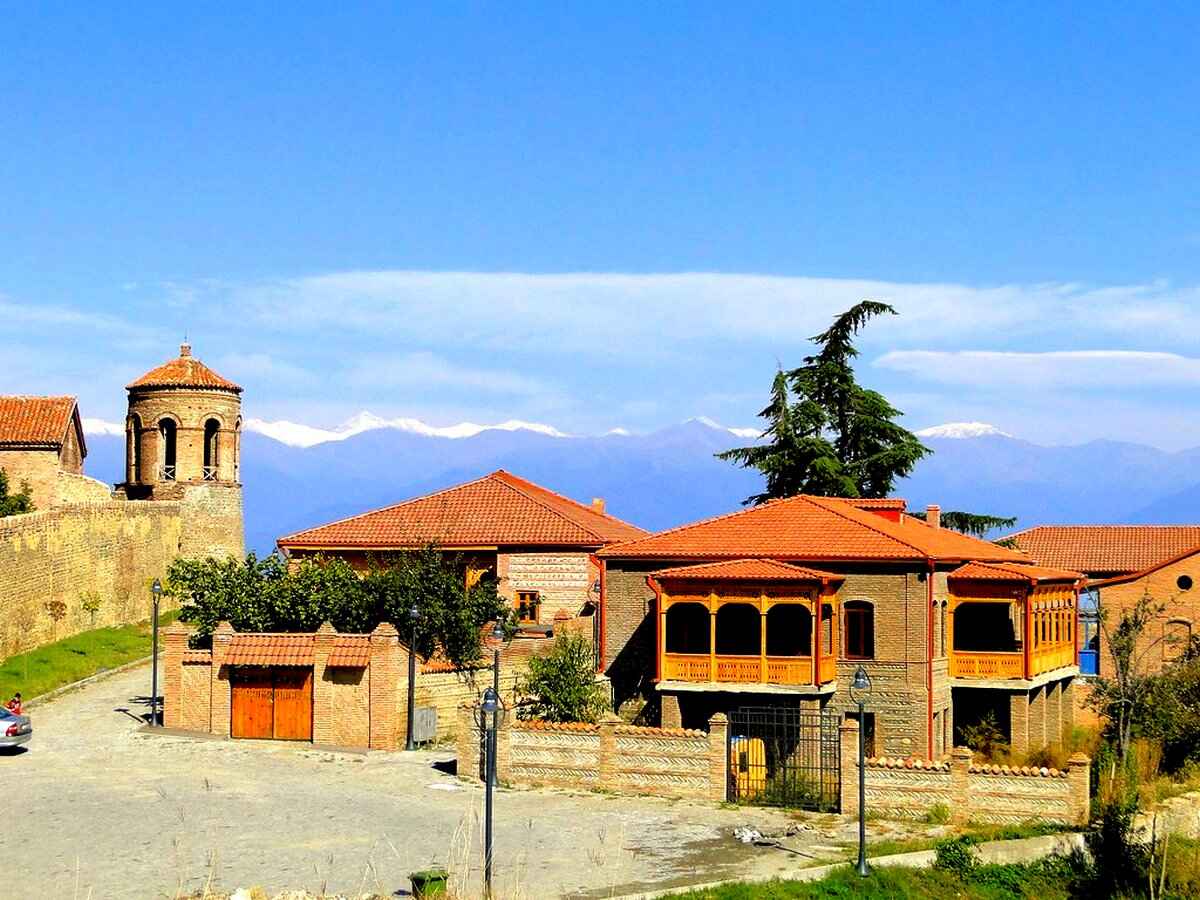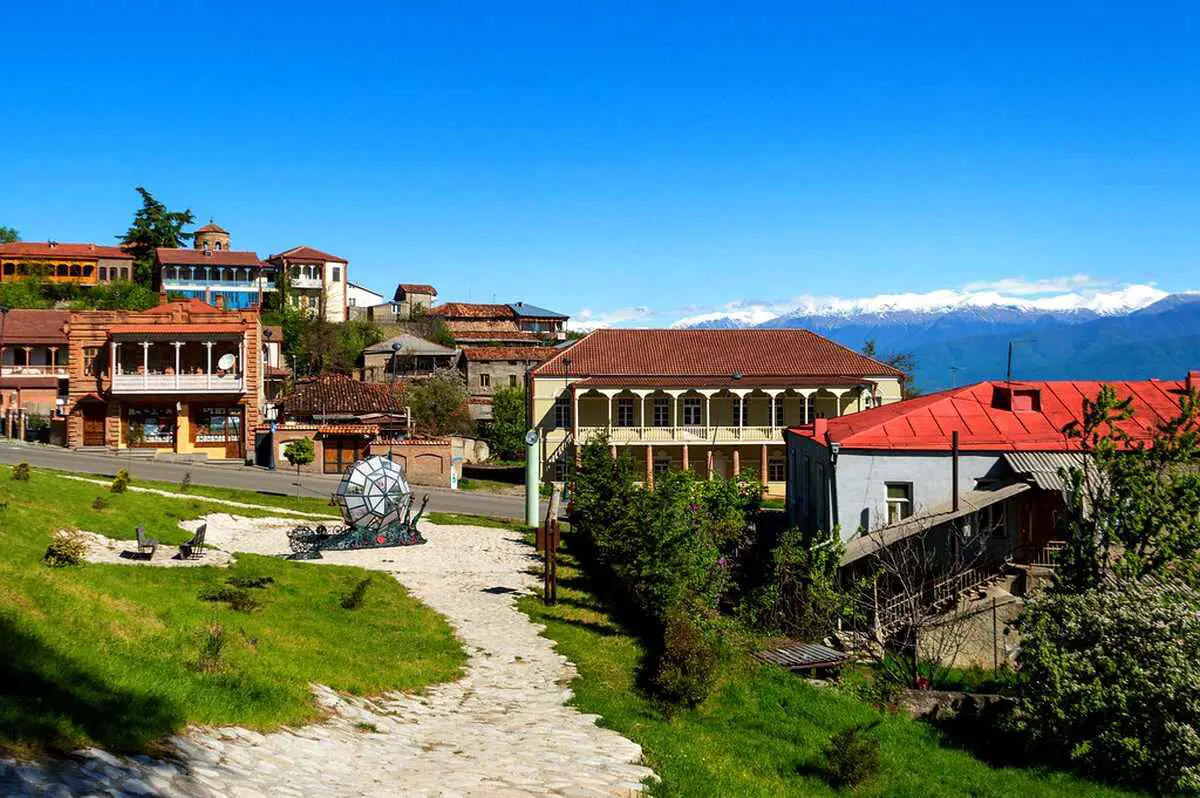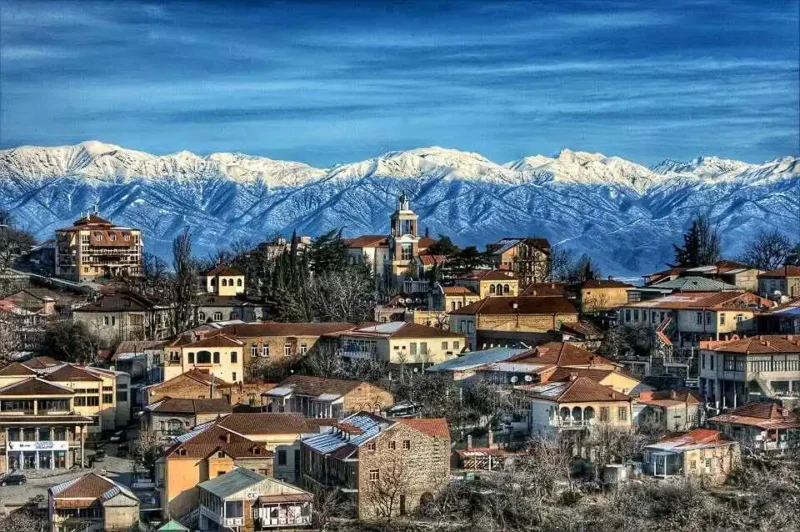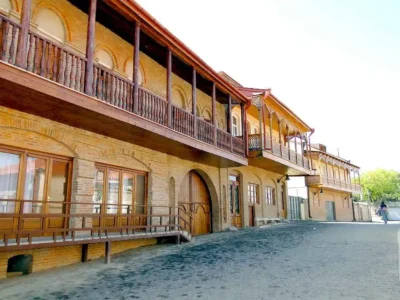Telavi is one of the oldest cities in Georgia, with unique traditions, distinctive colors and centuries-old history. It occupies a special place among the cities of Kakheti; It has the best geographical location and is rich in cultural sights.
Telavi is located in Kakheti, on the northeastern slope of the Tsiv-Gombori ridge and south of the right bank of the river Alazani. Alazani Valley and the beautiful Caucasus mountain range are perfectly visible from Telavi. Due to its original location, it attracted many visitors and travelers at all times.

In the history of Georgia Telavi is known as the ancient capital of the kings of Kakheti, the center of handicrafts and winemaking, an important educational center, where there was a seminary already in the 18th century.
Various opinions have been expressed about the origin of the toponymy of the city of Telavi. According to the famous Georgian historian, academician Ivane Javakhishvili, the name “Telavi“ was originated from the elm tree (in Georgian თელა [Tela], where the suffix “ვი“ [vi] is the grammatical marker of plurality and according to the contemporary Georgian grammar norms it means “Elm tree“.
According to the residents of Telavi, “there were many elm trees (თელა [Tela] in Georgian) on this place and that is why the settlement was also called Telavi.“ Even today, in the suburbs of the city, there is quite a variety of elm trees. Accordingly, most Georgian historians share the version of the origin of the name Telavi.
From the history of Telavi Archaeological excavations have confirmed that the first settlement on the territory of present Telavi appeared in the Late Bronze Age. During the Hellenistic period it grew and developed even more, and in late antiquity an urban-type settlement emerged at its base.
According to scholars, Telavi, as an urban settlement, was founded in the early stages of early feudalism from the ancient era, in the V-VI centuries, which is evidenced by the materials found during archeological excavations and the survived old cultural monuments. However, it is not mentioned as “Telavi“ in the narrative sources of that time.

In the V-VI centuries Telavi was a rather populous settlement and occupied the so-called “Ghvtaeba (Deity) Hill“ area between “Telavi gorge“ and “Kaklis Khevi“ (Walnut Tree gullet). The oldest architectural monument of Telavi “Ghvtaeba (Deity) Church“ is one of the buildings left on the Ghvtaeba (Deity) Hill. It is the defining and architectural dominant of the city silhouette.
Vakhushti Bagrationi dated Telavi as a city to the 10th century. The 10th century Arab traveler geographer Al-Maqdisi also mentioned it among the cities of the 10th century. Telavi was quite densely populated at that time and was located on one of the routes of the “Great Silk Road“.
According to historical materials, at the beginning of the XI century, after the annexation of the Kingdom of Hereti by Kvirike III the Great, Telavi became the capital of the Kingdom of Kakhet-Hereti and was the residence of the kings of Kakheti and Hereti.
At the beginning of the XII century, after Davit Agmashenebeli (David the Builder) annexed Kakhet-Hereti, the existence of the independent Kingdom of Kakhet-Hereti ended and it became a part of the united Georgian feudal state.
During the centurieslong Mongol rule in Georgia (30s of the XIII century 30s of the XIV century) the importance of Telavi was significantly weakened.
In the XV-XVI centuries Telavi was re-advanced, but its progress was hindered by Shah Abbas I four-way conquer in 1614-1617, mainly in Kakheti region.
The revival and progress of Telavi begins after the King Archil II of Kakheti (1664-1675) moved the royal residence of Kakheti from the ruined Gremi to Telavi in the second half of the 17th century. The beginning of the construction of “Akhali Galavani (new royal Wall)“ i.e.“Batonis Tsikhe (Royal Palace)“ in Telavi is attributed to the King Archil II.
From 1703 until the beginning of the XIX century, Telavi finally became the residence of the kings of Kartli-Kakheti and, at the same time, it was established as one of the important centers of Georgian political life and spiritual culture.
The King Erekle II made a great contribution to the revival and further development of Telavi city. He undertook significant reconstruction work – rebuilding

the wall of the “Batonis Tsikhe (Royal Palace)“, which had been started by Archil II. Construction of the Royal Court Chapel “Assumption of Blessed Virgin Mary“ is also attributed to his name.
[g-gallery gid=”3140″]
There were built the fortress belonging to the nobles in Telavi – the Vakhvakhishvili and the Korchibashvili-Rusishvili during the reign of the Erekle II near the royal residence i.e. on the eastern and western hills of socalled „Fikris Gora“ (Hill of Abstraction) and the “Ghvtaebis Gora (Deity Hill)“. The ruins of this construction are still preserved.
Telavi, like other large cities in Georgia, still had self-government in the era of feudalism. The Mouravi (Disposer) Institute managed the board with limited rights in the cities of Georgia.
After the forcible annexation of Georgia to Russia (1801-1810), for almost the entire twentieth century and the first twenty years of the twentieth century, until 1918, Telavi was one of the provincial centers of the Tbilisi Guberniya of the Russian Empire.
During this period, city life in Georgia was virtually dead. Its major cities, with the exception of Tbilisi, had lost their former importance and were transformed into “provincial cities“. Telavi shared the fate similar to other cities.
During the period of the Democratic Republic of Georgia, the importance of Telavi as a provincial city increased. After Soviet Russia ended the existence of an independent republic of Georgia in February-March 1921, until 1930, Telavi served as a province, and from 1930 as a city of regional subordination.
After the collapse of the Soviet Union, from the time of Georgia’s re-independence from 1991 to the present, Telavi has been the center of Kakheti Regional Administration.
In 2014, Telavi was declared a self-governing city. However, at the 2017 spring session, the Parliament of Georgia revoked the status of Telavi Municipality (or self-governing city). Telavi Municipality is a transformed so-called unified “community municipality“.
Telavi Innovative Tourist Routes Guide
